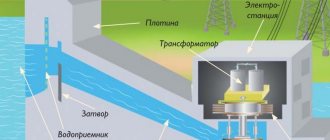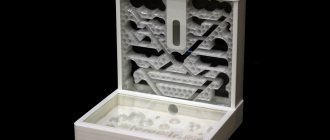What is water?
Such a question may seem not only strange, but also a little impolite. Who might not know this? Everyone knows that water is a compound of hydrogen and oxygen. Here is its well-known formula: H2O. Anyone who is used to washing their face in the morning, drinks tea, knows how to swim, loves to run in the rain without fear of getting wet, skates and skis is very familiar with water. And yet, I went to the library to find an answer to this question.
From books I learned that the name water dates back to time immemorial and since that time water has been called any “living” moisture that is so necessary for the life of people, animals and the nature that surrounds us. There is no exact definition of why water was called water, since each nation has its own name, which determines the meaning of water for others.
Water forms the water shell of our planet - the hydrosphere (from the Greek words “hydr” - water, “sphere” - ball).
Perhaps there is no more widespread and at the same time more mysterious substance on Earth than water. Indeed, it is enough to remember that all living things came from water and consist of more than 50% of it. 71% of the Earth's surface is covered by water and ice, and much of the northern landmass is permafrost.
To visualize the total amount of ice on our planet, we note that if they melt, the water in the World Ocean will rise by more than 50 m, which will lead to the flooding of gigantic land areas throughout the globe. Huge masses of ice have been discovered in the Universe, including the Solar System. There is not a single more or less significant production or human activity in which water is not used.
The famous Soviet scientist Academician I.V. Petryanov called his popular scientific book about water “The Most Extraordinary Substance in the World.” And Doctor of Biological Sciences B.F. Sergeev began his book “Entertaining Physiology” with a chapter about water - “The Substance that Created Our Planet.”
Conclusion: water is a familiar and unusual substance.
Sample for high school students
In high school, a student must be able to think independently. Tasks become more difficult; when performing them, not only deep knowledge is important, but also creativity. This is especially true, of course, in the humanities. Flights of fancy should not lead to distortion of facts.
Here is one example of how you can do creative work on the topic of what is the beauty of water:
- The water surface is always beautiful. If the river is not covered with ice, it itself looks alive. Its waves speak to people in their own language, whispering something mysterious and pleasant.
- There is no comparison to the impression of the lunar path along which you can ride a boat on a starry night. At such a moment a person becomes a real part of the Universe. It seems that this feeling will last forever.
- But even in winter, when you can skate or ski on the vast expanse of ice, enjoy the vastness of the plain and fresh air, life continues a few centimeters below. To be convinced of this, you just have to remove the snow near the shore, rub the ice to a mirror shine - and the winter fairy tale will be clearly visible.
- The surface of a river or lake, if it is not abundantly covered with snow, will shine almost until spring. Gray, dirty tones will not be able to dominate her for long. A noisy ice drift will begin, small pieces of ice and huge blocks of ice will float downstream.
- Even when the river just begins to open up, it is not safe to walk on the ice. But it’s also nice to watch the majestic spectacle from the side, from the shore.
- With the arrival of spring, the banks of the river come to life. The grass is breaking through, leaves are appearing on the trees, and the first spring birds are here.
- So the seasons will pass the baton to each other, revealing more and more new colors of the viviparous principle.
- But this relay race will be eternal only if humanity can finally learn to take care of nature, and the elders will show the younger ones examples of a worthy attitude towards both a small spring and a huge ocean.
If such a statement of thoughts seems too short, it can always be expanded by using epithets and increasing the number of vivid examples from real life. You can add arguments about the desire to demand stricter requirements for industrial enterprises that discharge contaminated water in the author’s hometown.
Ideally, the essay should also have some kind of educational role. In the water theme, it is easiest to emphasize the issues that humanity will feel safe only if there is enough water for everyone on Earth.
Physical properties of water
From the lessons of the surrounding world: we know that water is the only substance on Earth that exists in nature in three states: - Solid - ice. - Liquid - water. - Gaseous - water vapor.
Water is such a unique substance that can change from one state to another and back with minor changes. During transitions from one state to another, various processes can occur: evaporation (water from a liquid state gradually turns into air in the form of vapor), condensation (water vapor turns into a liquid or solid state), frost formation (frost formation - the transition of gaseous water into a solid state ), freezing (liquid water turns into snow, ice).
Thus, water can carry out not only gradual transitions from one state to another (ice - water - steam - water - ice), but also abrupt transitions, bypassing some phases (ice - steam or steam - frost). When water transitions from one state to another, its properties change significantly.
However, in the encyclopedia we read that scientists distinguish 5 different states of water in liquid form and 14 states in frozen form.
Conditions are also possible - supersaturated steam, superheated liquid, supercooled liquid. These states can exist for a long time, but they are unstable and upon contact with a more stable state, a transition occurs. For example, it is not difficult to obtain a supercooled liquid by cooling pure water in a clean vessel below 0°C, but when a crystallization center appears, liquid water quickly turns into ice.
At atmospheric pressure, water freezes at 0°C and boils at 100°C.
"Glass" water. At a temperature of -38 °C, even the purest, ultra-chilled water will suddenly turn into ice. At -120°C, water becomes hyper viscous or stringy, like molasses, and at temperatures below -135°C, it turns into “vitreous” or “vitreous” water, a solid that lacks a crystalline structure.
Over cooling water. Very pure water has this property. When cooled below freezing point, such water remains liquid. Its crystallization can be provoked by gas bubbles, impurities, or an uneven surface of the container. When the crystallization process starts, you can see how super-cooled water instantly turns into ice.
Typically, the properties of water include:
- transparent,
- colorless,
- without smell,
- fluid,
- takes any form into which it is poured,
- may freeze
- may evaporate
- water expands and contracts
- dissolves substances.
Water is an amazing substance. Unlike other similar compounds, it has many anomalies. These include unusually high boiling points and heat of vaporization. Water is characterized by high heat capacity, which allows it to be used as a coolant. The unusually high surface tension of water has determined its good ability to wet the surfaces of solids and exhibit capillary properties, which gives it the ability to rise up through the pores and cracks of rocks and materials in defiance of gravity.
A very rare property of water is manifested when it transforms from a liquid to a solid state. This transition is associated with an increase in volume and a decrease in density.
Scientists have proven that the structure of water in the solid state has cavities and voids. When melting, they are filled with water molecules, so the density of liquid water is higher than the density of solid water. Since ice is lighter than water, it floats on it rather than sinking to the bottom.
The ability of water to expand when freezing brings a lot of trouble in everyday life and technology. Almost every person has witnessed frozen water breaking a glass container, be it a bottle or a decanter.
Another interesting property of water: an increase in pressure leads to the melting of ice. This can be observed in practice, for example, the sliding of skates on ice. The area of the skate blade is small, so the pressure per unit area is large and the ice under the skate is corrected.
Interestingly, if high pressure is created over water and then cooled until it freezes, the resulting ice under conditions of high pressure melts not at 0°C, but at a higher temperature.
Thus, ice obtained by freezing water, which is under a pressure of 20,000 atm, under normal conditions melts only at 80°C.
Another anomaly of liquid water is associated with an uneven change in its density with temperature changes. It has long been established that water has the greatest density at a temperature of +4°C. When the water in a reservoir cools, the heavier surface layers sink, resulting in good mixing of warm and lighter deep water with the surface water.
Conclusion : water is amazing for its most common properties. And we will consider these properties in the practical part and demonstrate some of the most interesting experiments.
Sketches for the little ones
One must be fully aware that a good description of the beauty of water is unthinkable both without colorful comparisons and without knowledge of the subject itself. A child will still be forgiven for the one-sided expression of thoughts (here we are talking, rather, about emotions), but older students will need something more than ordinary descriptiveness. It is imperative to keep in mind the topic within which the task was given.
Stories based on illustrations and video sequences
Younger schoolchildren can express their attitude to the subject of the description on the basis of a fairy-tale perception of the world, drawings in books, animated films, and explanations of adults. Children taking their first steps in school should not be prevented from expressing their feelings. It would be more correct to simply advise something, to give a gentle push in the right direction.
A story based on pictures or video may look like this:
- There is water all over the Earth. That's why our planet looks blue from space.
- It has seas and oceans. There are large snow caps at the poles.
- The earth is nourished by rain. Without them, all living things would die.
- They fill lakes and rivers. Fish and other creatures live in bodies of water.
- Without rain, plants would not grow. There would be no food for animals.
- You cannot drink from open bodies of water. They contain harmful and toxic substances.
- The most beneficial water is found in clean streams coming out of the ground. It is also mined using special wells.
- There is less and less clean water on Earth. She needs to be protected.
This is, of course, a short version of the work. But it can be taken as a basis. At primary school age, basic concepts and knowledge will be enough.
Fairy tale version
Water can truly bewitch. There is something magical about it. Otherwise, there would not be so many fairy tales, legends and traditions in the world associated with the sea elements, river surfaces, underground lakes, and wells. It is quite possible to compose a short story about the beauty of water on this basis. What is good about this form of material is, first of all, that the work will be unique.
A child can come up with a fairy tale on his own. For example, like this:
- While walking through the forest, the boy Sasha accidentally found an inconspicuous source. It was hidden among the grass, flowers and trees. The same invisible path led to it. It was so small that it could probably have been built by ants.
- This riddle interested the boy so much that he began to make his way to the spring every day. Sasha lay behind the trees for a long time and watched the key. Real life flowed slowly next to him. Butterflies landed on the flowers. Dragonflies flew over the spring. Rare rays of the sun gave magical beauty to the reflections on the water surface.
- A wonderful world opened up for Sasha. Insects and small animals rustled in the grass. The mice came running to drink from the clear spring. Small burlap trees provided shade for the animals while they happily played near the spring.
- A very small stream flowed from the source. Behind the nearest trees it dropped down into a small waterfall. Rays played on the drops flying to the sides.
- Sasha would have watched the life of the fontanel for a long time if one day the small animals had not asked him not to bother them.
- The boy was interested in continuing his observations. But he decided to listen to the animals.
- Sasha realized that it was impossible to disturb nature in vain.
Such stories told by children look entertaining, especially if they have the effect of presence, that is, they are told in the first person.
It is necessary to use as many details as possible in your work. But they should be relevant to the matter, not distracting from it.
Secrets of water
Modern science continues to study and discover new properties of water. While studying the properties of water, we learned a very interesting fact. Water has a “memory” - it accumulates and stores the information communicated to it. If you say kind words or beautiful music to the water when it freezes, you get magnificently beautiful crystals, but if the words and music were aggressive, the crystals turn out small and ugly. Japanese scientist Masaru Emoto has been engaged in this research for more than twenty years.
It is assumed that ocean water preserves the memory of the creatures that lived in its depths. Glaciers can also contain millions of years of our planet's history. According to the head of the laboratory of the scientific and experimental center of the Ministry of Health of the Russian Federation, Stanislav Zinin, water does not consist of individual molecules, but of large compounds, including up to 900 molecules - so-called clusters.
Water, consisting of many clusters of various types, perceives, stores and transmits a wide variety of information. Water reacts to the thoughts and emotions of the people around it, to events happening to the population. The crystals formed from the newly obtained purified water have the simple shape of the well-known hexagonal snowflakes.
The accumulation of information changes their structure, complicating them, increasing their beauty if the information is good, and, on the contrary, distorting or even destroying the original forms if the information is evil or offensive. We observed a situation where crystals formed from water located next to a flower repeated its shape.
Thus, water has a memory that allows it, even after significant dilution, to recognize the information stored in the molecules. At the same time, negative (in the sense of harmful) information is also retained. Water circulates around the globe, flows through our bodies and is carried throughout the world. If we could read the information stored in the memory of water, we would know the story.
During the survey, we asked the guys a question about “holy” water. It turns out that many people have it at home, but its properties are not known. As part of our research work on the physical properties of water, we found out the following. Holy water in Greek is called “great agiasma”, that is, “great shrine”. In Rus', for a long time, they believed that on the day of Epiphany, water acquires special healing properties: you cannot catch a cold in it, it will protect a person from illness, damage and the evil eye.
They also believed that on the night of Epiphany, the water in all sources was sanctified by itself, regardless of church ceremonies. But scientists have proven that holy water has a high silver content, therefore has great cleansing capabilities and really helps the human body, correcting the functioning of unhealthy organs.
Conclusion: to understand water is to understand the universe, all the wonders of nature and life itself.
Study of water properties
The goal of our research work is not so much to achieve our own scientific results, but to gain basic knowledge, skills and abilities in the field of scientific research methods.
In order to clearly see the amazing properties of water, you can conduct the following experiment.
Project equipment: glass, water, coins, plastic card.
1. First, put the card on an empty glass and try to place a coin on its edge.
Result : the card falls.
2. Now pour water into the glass to the top and repeat the experiment. We will carefully place one coin at a time on the edge of the card.
Result : the water held 5 coins.
Conclusion: The larger the area of contact between the surface of the water and the card, the more force must be applied to break this connection.




